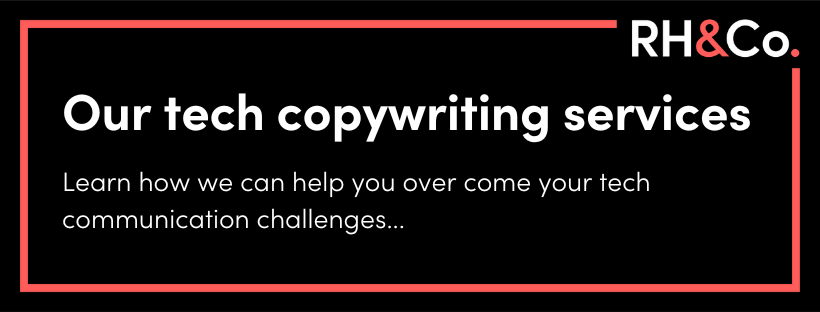

Clear as nanocrystal: How to market complex technology
Sell the benefits not the features. Sell the lifestyle. Simplify. That’s the marketing advice you might have followed before you started marketing complex technology. Then you hit a brick wall. Or possibly one made of plasma.
That classic marketing advice has its place – but it doesn’t always work when your company has a chief science officer, or your target audience includes CTOs, or when 50% of your audience doesn’t understand what your industry even is.
Here we outline the challenges of marketing complex technology, why traditional marketing advice doesn’t always suit, and what alternatives actually work.
TL:DR
- Challenge 01: Your audience is often confused
- Challenge 02: Your audience is sceptical
- Challenge 03: Your audience is sometimes expert
Challenge 01: Your audience is often confused
It’s not just innovation that can get complex, it’s often the context too. Cybersecurity products provide nuanced solutions to multifaceted threats. Biotech addresses gaps within disease detection that impact a sprawling NHS infrastructure. Embedded finance solves money flow issues that most businesses don’t even know exist.
Audiences don’t always see the wider picture. Sometimes it’s like starting in the middle of a Christopher Nolan film and expecting a new audience to understand why solving that equation on Michael Caine’s blackboard really matters. Or why it’s a bad thing to die when you’re in a dream within a dream.
If people don’t really understand the problem, they’re not going to be won over by the solution.
Solution: Don’t just simplify; make people curious
Simplicity works. To a point. While you can’t afford to distract customers with superfluous detail or technical language that won’t resonate, you also can’t afford to simplify your product or service’s true value away.
Instead of aiming for simplicity, aim to capture attention. If you can find the one line that will disturb your audience’s status quo, they’ll become interested enough to grapple with what you have to say. And if you can make someone curious enough to learn about their problem, they might become interested in your solution.
This is a challenge that one of our clients, Weavr, is taking head on.
Their emerging industry of embedded finance is full of brands offering solutions that appear almost identical. All seem to offer digital cards, a better payment experience, and so on, but the blurred lines around compliance are causing some buyers to invest in the wrong technology for their business.
As a result, Weavr are doing everything they can to communicate the difference – smart messaging, thought leadership, and strategic content campaigns. While they don’t burden their audience with every detail behind how embedded finance works, they’re very good at getting you to care about the next thing they have to say, so that buyers can make an fully-informed decision.

Challenge 02: Your audience is sceptical
Complex technology in the B2B space usually falls into one of two categories:
- It’s emerging technology and relatively unknown
- It’s proven but the market is flooded with similar products
Noise and unfamiliarity both breed scepticism – not in everyone, but enough to make it tougher once you’ve run out of early adopters. That scepticism is fuelled by the habits of some technology marketers, who are determined to make a multi-faceted product or service sound as simple as possible.
The oft-touted argument is that people don’t need to understand the combustion engine to buy a car. But this is often a flawed comparison. First, the car is a proven concept, and your technology might not be. If you were to step into a self-driving car in London traffic, you might want a bit more explanation about how it keeps you safe first.
Second, most car manufacturers are also known quantities. People don’t need as much context when they already trust a brand, which is why when Google released their Pixel phone, they could just advertise it as ‘The Google Phone’ with no additional copy. People understood the brand, so they understood the value of the product.
Too many marketers act as though they have this luxury when their brand hasn’t earned it yet. Over-explaining features used to be a flaw of the technology industry, but now too many of us have swung to the other extreme, relying on hype language and presenting a company’s technology as if it’s a magic show.
You can do this once you’ve got an expert reputation, but when you’re relatively new in the market, or the market itself is new, you can’t afford to dish out too much hyperbole. Particularly in B2B. Hype never works on the sceptical – in fact it puts them off.

Solution: Don’t offer hype; make the technology human
It’s easy to lead with hype, which is why so many brands do it, recycling adjectives like ‘adaptable’, ‘state of the art’ or ‘innovative’ until they all sound like generic keys to a vague future.
Instead of hyping up your product or service, drill down into your audience. What do they care about? What are they already doing that your tech reimagines? What will be their experience of your product on a human-level?
Libeo’s accounts payable SaaS platform does this brilliantly, without falling into the trap of so many automation-led products, which usually say things along the lines of ‘less paperwork’, ‘no admin’ or the most cheesy line in all B2B marketing, ‘We take care of X, so you can focus on what you do best.’
Instead Libeo, who we worked with on a series of customer-focused blog posts, plays to specific verticals in their small business audience, talking to hospitality with phrases like “wait on your tables, not for your invoices” or speaking to e-commerce: “sell in a single click? Then pay that way, too.”
Stories are complex tech’s best friend – real accounts of real people experiencing your product, working behind the scenes of your organisation, or taking the lead through your services. If you’re interested, you can see how we did this for one multichannel sales tech company.
Challenge 03: Your audience is sometimes expert
Some technology companies are lucky: they have one customer persona – expert or non-expert – and they can pitch their product or service at this exact frequency.
This is rare, however, particularly for B2B technology that requires purchasing sign-off from multiple departments, some tech-fluent and others not. We’ve often had to tailor a tech company’s messaging five ways – between startup level CTOs and CEOs, as well as enterprise level CSOs, CIOs and CEOs.
Alternatively you might be skipping a tech audience altogether but you still might be talking to experts of another kind – ecologists, HR directors, civil servants. Here you need to translate your technical expertise, not so anyone can understand it, but so a specialist in another field can appreciate it.
The danger here is your content marketing can easily come across as patronising, or ill-informed. The number of HR-tech platforms with blogs offering basic HR advice – sometimes generated by AI – to seasoned HR professionals is surprising, since it’s the kind of content that would make a potential customer think a brand’s technology is beneath them.
Solution: Don’t silo the marketing dept; build your brand together
Since your audience is likely to have many faces and facets, you’ll want your messaging and comms to be as complete and rich as possible.
That means you mustn’t silo your marketing team. Gather members of your wider team to help define your brand, and create messaging pillars that will resonate with every level of your audience. Check out our Brand Roundtable discussion on ‘Defining your brand: who should be involved?’ to learn more about how to do this.
The same applies to content. Your team is full of specialist understanding, so mine their expertise and showcase it if it’s relevant to your audience. Get your marketing team to interview external experts when you need to talk beyond your remit, complete original research if you can, and – whether your team is full of data scientists, technical advisors, or mathematicians – keep them talking to your marketing people.
Having interviewed a plethora of technical authorities over the years – from algorithm auditors to penetration testers and leaders in fintech – we’ve learned they’re the ones who can often pull out a new conceptual model on the fly, or drill down into the nuance of a subject.
They might want to say too much, sure. And you might need a copywriter to arrange what they say on a page, or hone it into a video script for your audience, but your experts’ input is what gives your brand the depth and authority it needs. That’s what enables you to begin a lasting conversation with your audience, one where they’ll listen long enough to see why they need your complex tech.










